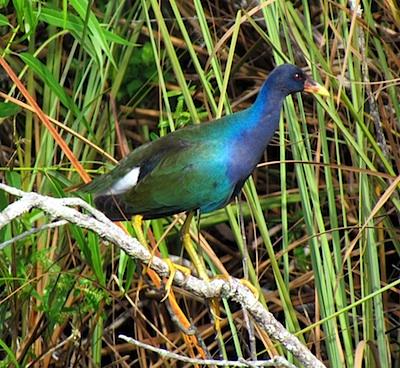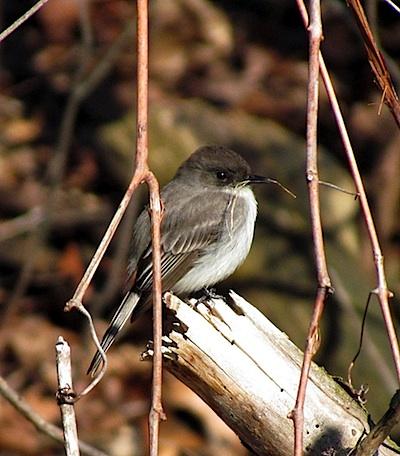Sometimes it's cold enough that birding just isn't that much fun. Sure, when it's -10°F the birds are still around (as I talked about here a couple weeks ago), but I'm not 20 anymore and freezing isn't my cup of tea. Before long I'll be a snowbird.
In the meantime, it's time to sit at home and plan my year. I've noticed quite a few national parks popping up on my destination list for the year. Here's a preview of what you may be hearing about in 2014:
March will find me heading south, because I expect to be utterly done with winter by then. Big Cypress National Preserve and Everglades National Park are on the agenda. I've birded those parks before and I know where the good spots are. The first trip to a new place is always a thrill, but I have to classify those as scouting missions.
On my first excursion in a place like Everglades, I'll try to get a quick look at everything. Obviously that means I don't get a good look at anything, but that's ok with me. My scouting of Everglades revealed a few places that warrant some extra attention this time around. Paurotis Pond is legendary as the place to see the charismatic Roseate Spoonbill, and the legends don't lie.

Birders in Everglades National Park should keep an eye out for Purple Gallinules. Kirby Adams photo.
The pond is awesome for those big pink birds and a variety of other waterfowl. But I noticed something else while sitting at the picnic tables near the Paurotis Pond parking area. The trees around the lot were filled with songbirds. I didn't have time to properly explore the woods there, but I made a mental note of that for my return trip.
Looking at a satellite image, I see that the area surrounding the parking and picnic area at Paurotis is the only densely wooded patch for miles in any direction. That explains the concentration of songbirds.
I've never birded Biscayne National Park, but it really shouldn't need much scouting. The vast majority of the park is underwater, which isn't premium birding territory. I've heard that the mainland sliver of the park is a good spot for the elusive Mangrove Cuckoo, however. That's my target for Biscayne in March ' a relative of the roadrunner that hides out in mangrove trees.
On the way to Florida, I hope to return to Congaree National Park in South Carolina, a spot I haven't 'birded' in seven years. That's a different situation than a return trip to somewhere like Everglades. In the case of Congaree, I wasn't really a serious birder on my first visit. I was looking for birds, but truth be told, I didn't know what I was doing. Dense mixed forests aren't necessarily the most productive habitat for birds, and it's certainly not the easiest birding. That could explain why my South Carolina list for 2007 is so meager. I hope to rectify that with at least one morning of dedicated canvassing of the cypress, tupelo, and loblolly pine canopy.
Once spring finally arrives, I'll be spending a lot of time around my 'home' parks, particularly the national lakeshores. Indiana Dunes and Sleeping Bear Dunes national lakeshores will get at least one visit each. Checking out the Piping Plovers at Sleeping Bear is a late-spring tradition. Indiana Dunes is a pleasant April getaway with spring arriving there a full week or two before it does at home just a couple hours to the east.
Pictured Rocks National Lakeshore will likely get to see my binoculars before summer gets rolling. I need to get to the Upper Peninsula to see a Connecticut Warbler and I can't go up there without visiting a park known to host 23 species of nesting warblers.
Spring should also find me crossing the northern border to check out the spring birding festival at Canada's Point Pelee National Park, which is oddly southeast of my home. Point Pelee is a triangular peninsula jutting into Lake Erie directly across from the holy birding grounds of Magee Marsh in Ohio.

The Eastern Phoebe is one of the first spring birds in the east. Kirby Adams photo.
Warblers and migratory songbirds pass through in the millions every May, and I'll likely be at festivals celebrating that event on both sides of Lake Erie.
The height of summer isn't a great time for birding around these parts. Nesting behavior is done, so no one's singing, but migration is still a ways off. That makes heading up in elevation a good strategy for the birder, except that Michigan doesn't provide a whole lot of vertical relief. So, I've got Rocky Mountain National Park on the agenda for July. I've never been there, so this will be one of those scouting trips.
Hopefully, my quick stops at high elevation will produce a ptarmigan or two. Cassin's Finch and American Dipper are two other birds I really should have seen by now, but are sadly missing from my life list. After that, it will be fall, which is followed by winter. I'm not much in the mood for winter right now, so I'm cutting off the 2014 planning with August.
What about you, Traveler readers? Planning on any trips to see a bird or birds in our national parks this year? Does anyone else do the 'scouting' type of visit to a new place, or is that just me?



Add comment